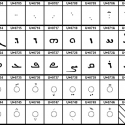This is the first part of a series of posts by the Digital Orientalist’s Syriac Studies Editor, Ephrem Ishac. This post acts as an introduction to Ishac’s interview with George A. Kiraz which will be serialized in later posts.
In 1993, Sebastian Brock, the most prominent scholar of Syriac studies, wrote the following words in the foreword of George Kiraz’s Computer-Generated Concordance to the Syriac New Testament:
‘it marks a very successful marriage of Syriac scholarship with the ‘Electronic Age’, especially in the field of Literary and Linguistic Computing.’[1]
In fact, Brock was right in his expectation about such a successful marriage between Syriac as an ancient world heritage and digital culture!
Since that time, the field of Syriac Studies has started to incorporate, rather than depend on the Digital World, reaching what is today called “Syriac Digital Humanities.” Kiraz and his colleagues successfully produced a Unicode Standard version of the Syriac Alphabet, reserving an independent Unicode block for the Syriac language, which contains characters for various fonts of Syriac scripts including the Estrangela, Serto, Eastern Syriac, and the Christian Palestinian Aramaic variants. Initially, the main goal for this Syriac digital revolution was to focus primarily on Computational Linguistics especially digital lexicography, but later other scholars started to build various projects that broadened the field of Syriac Digital Humanities. Moreover, since the Syriac language is still a living heritage spoken and used liturgically by the followers of this Church tradition, Syriac Digital Culture could easily be introduced inside Churches.
Indeed, it is true that, if they had existed, digital tools could have helped to fulfill the dreams of many scribes and authors who wished to produce texts in a fast and accurate way. I think we can draw a similarity between the invention of printing and the production of digital texts. One of the best examples is possibly the case of Moses of Mardin, a 16th Century scribe who produced many Syriac manuscripts. Having heard about the invention of printing in Europe, Moses travelled to Rome[2] where he could achieve his dream by printing the Syriac gospels in Vienna in 1555. This was the first time in history that a book in Syriac was printed, and since that time, the West has been able to know and learn about Syriac Christian literature.

